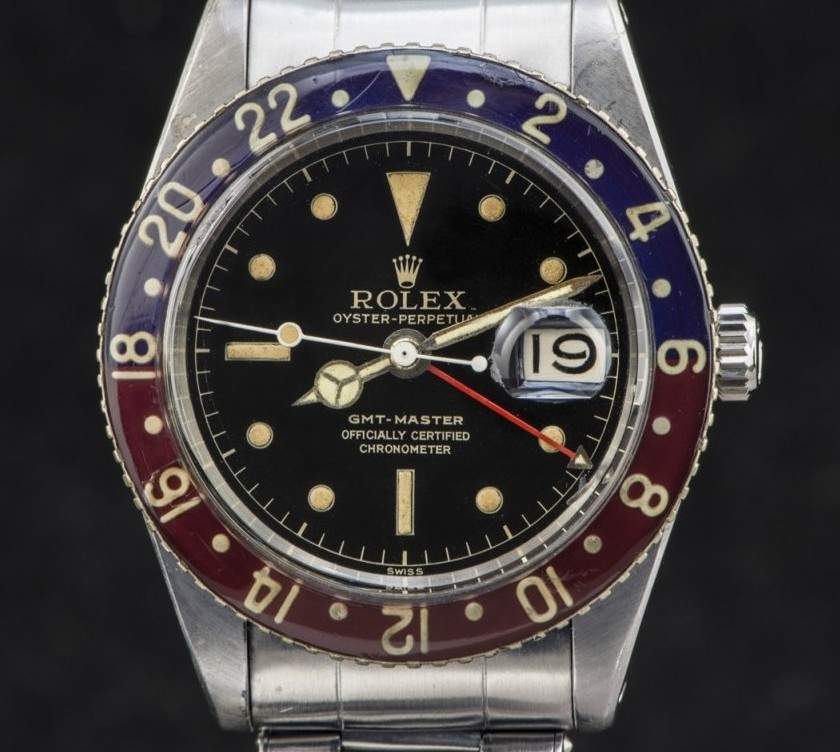
A personal bond for the GMT Master
I will state this openly.
The GMT Master is my favourite reference, model, line (whatever you want to call it) within the Rolex universe.
Why?
Well for a start my 18th birthday present was a bi-color gold GMT Master given to me by my mother in 1992. So the GMT Master has a special place for me personally. But I like the GMT Master for two other reasons.
The first is color. I love colors and I think vintage watches really is about color. Lets think about it. Collectors often talk about Patina. Or tropical. Or shades of brown. They are always referring to color. There are few watches that have more attractive colors than the GMT Master, especially the first reference the 6542 with its fragile but beautiful bakelite bezel insert.
The second appeal the GMT master has in my view more so than other lines is the concept of ‘tool watch‘. In fact collectors often cite the tool watch concept as one main reasons they like vintage Rolex or any Rolex for that matter. Rolex watches not only looked good, they were durable and had a function.
When I think of a tool watch – I think of the GMT master -even before the submariner.
Yes the submariner (introduced by Rolex in 1954) might have come before the GMT Master (1955) but the story of the creation of the GMT Master is more charming in my view.
Created specifically for PANAM pilots in the 1950s, Rolex introduced its first dual time zone watch, the GMT Master 6542 to help pilots better keep track of multiple time zones.

(Credit: Delta heritage museum, 1958 ad showing first class section).
The first GMT Master was the 6542 (main picture above), and this will the focus of our report.
In 1959 Rolex replaced the legendary 6542 with the 1675 which would go on to last more than 20 years. While the 1675 is an extremely attractive GMT Master reference and some of the most beautiful and rare versions exist like the double swiss underline GMT (see post here), the holy grail in GMT Master collecting -remains the 6542 – especially those with Bakelite bezels. They are the most beautiful, the most colourful and probably the most rare of all GMT models.
In my opinion also the most beautiful – good enough reason to take a closer look at this icon.
Background information
In the 1950s America was experiencing a post war economic boom.
The economy was expanding and the jet age was just being introduced. People like Frank Sinatra and Eva Gardner were traveling to exotic places and inspired a whole generation of middle to upper class Americans to travel abroad. One of the largest and most successful airlines at the time PANAM – wanted their pilots to have a reliable, accurate and durable watch in order to keep track of multiple time zones.
Rolex delivered with the 6542 GMT Master – the first dual time zone watch, Officially Certified Chronometer. The GMT Master quickly became the de facto choice for airline pilots. Rolex clearly laid out the advantages of the new GMT Master in its advertising below (see the seven wonders of the GMT Master).
One of the seven wonders (the super luminous) would turn into a large headache for Rolex as the company had to recall most 6542 in the US due to Radium being used (more on that later).
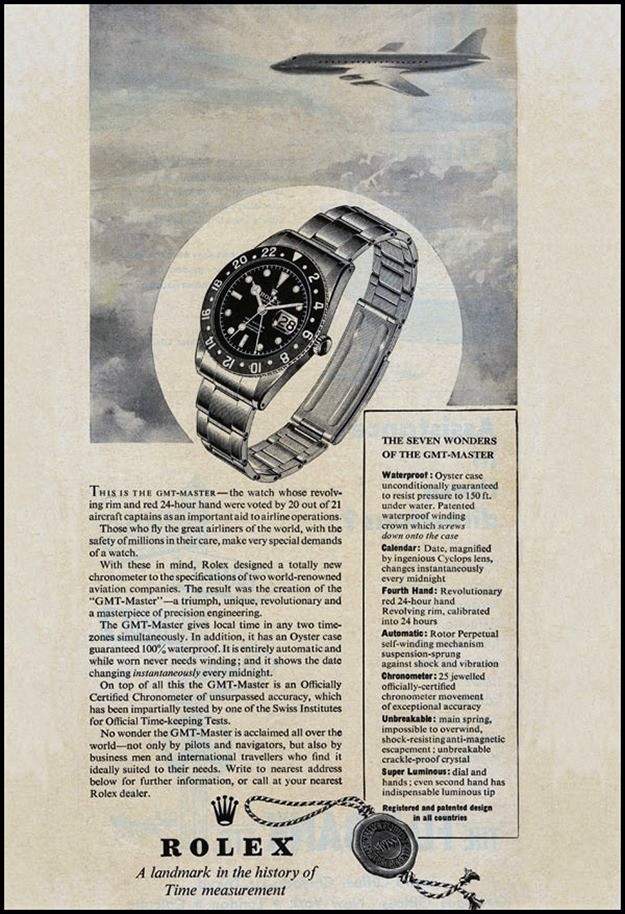
(Credit: Amanico Purists Pro)
Another advertisement by Rolex for the international traveler. In my opinion this form of tool-watch is highly appealing. Travel, adventure, new places, flying – the GMT Master captured the imagination of many given their hunger to travel in a post -war world.
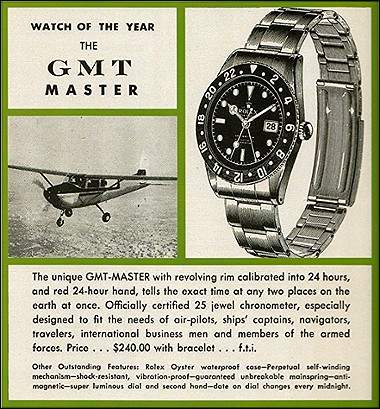
(Credit: Amanico Purists Pro)
Bakelite & Dial Configurations of the 6542
Before we go into the dial and hands of the ‘normal’ black gilt dial 6542 bakelite (that is also the focus of this report) let us try and summarize the different versions that exist of the 6542 bakelite Rolex GMT Master. Click on the links below to see the different dial variations.
- Blue /red bakelite, black gilt dial, GMT writing in gilt, steel watch.
- Blue /red bakelite, black gilt dial, GMT writing in pink, steel watch.
- Blue /red bakelite, black gilt dial, GMT writing in pink & red depth, steel watch.
- Brown bakelite, brown and nipple dial, GMT writing in gilt, 18k gold.
- Brown bakelite, white and nipple dial, GMT writing in black, 18k gold.
- Brown bakelite, gold dial, GMT writing in gold, 18k gold.
- Black bakelite, brown and nipple dial, GMT writing in white, 18k gold.
- Red / blue non bakelite, white dial, GMT writing in black, steel watch- Albino
Credit: Picture 1-5 (J Goldberger /P Stahl) / Picture 7-8 Giorgia – Mondani Books
Dial and Hands configuration of the 6542
When Rolex introduced its first GMT Master the 6542 in 1955/56 it was not very different from other Rolex sports watch models.
The dial was a glossy (or mirror) and not matte, which is correct for the period. The writing, like many early Rolex sports watches from the 1950s had gilt (golden) writing. The dial additionally had a chapter ring much like the submariners of this period. The earliest 6542 are known to have the GMT Master line of writing in pink (see picture below) but very few have this configuration.
Most 6542 after 1957 have the ‘normal’ Mercedes hands (like the submariners) and as seen in the picture below. The very earliest versions of the 6542 GMT Master have a long neck or swan neck hour hand (see picture below)*, much like the 6350 Explorer or the 6205 submariner. It is only the 14 or 18k gold versions that do not have Mercedes hands but rather have stick or dagger hands as can be seen in the pictures above (see 6542 dial configurations). Also some 18k gold version had double signed dials, which was common for Rolex sports watches at the time.
For example in the dial variations (listed in the 8 points above) you can see a 18k Serpico & Laino version, very rare and beautiful with brown dial and white printing.
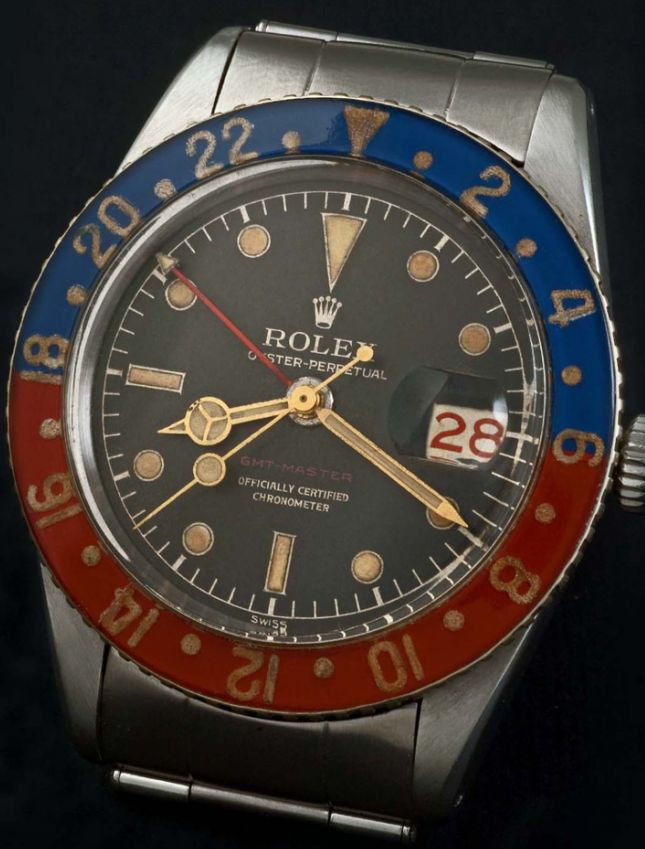
(Credit: J Goldberger)
The pink GMT Master is very rare. Here another close-up of this rare dial configuration.
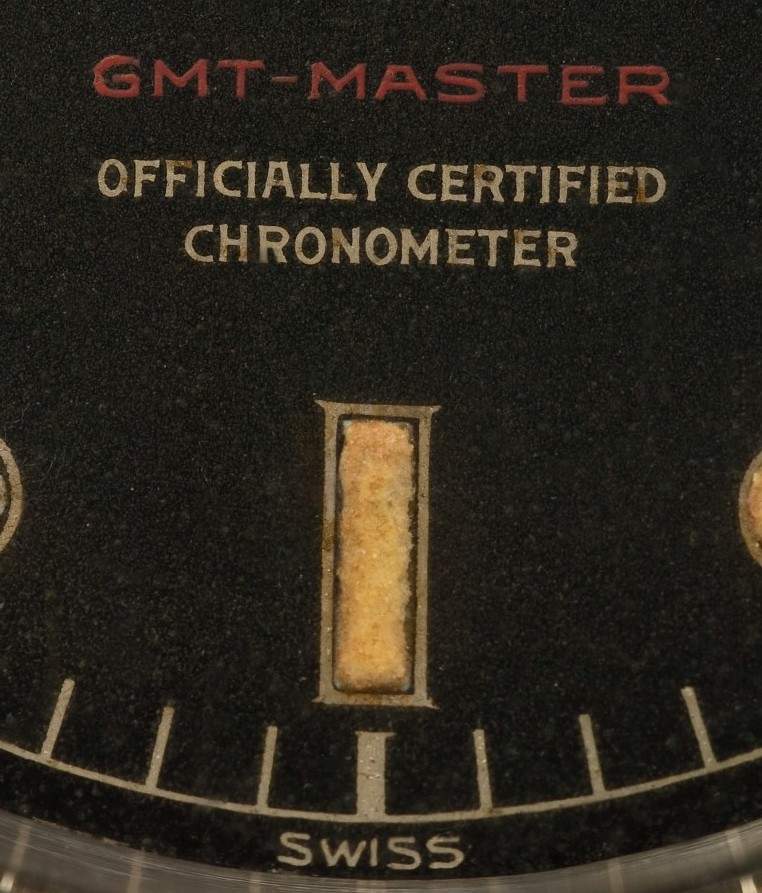
(Credit: J Goldberger)
Another extremely rare 6542 dial configuration is the 6542 ‘pink writing’ and ‘red depth’ rating.
This dial configuration is also only seen in the very earliest of 6542. These watches are very rare and I have only ever seen one example. Notice the depth rating which only half the depth of the submariners at the time (the GMT is not a diving watch – remember).
Also interesting to note is the hour hand which is not a long neck or swan version. Maybe we can safely assume that the long neck hour hand is only with the 6542 pink GMT writing and not with the additional ‘red depth’ rating. Notice also that this watch also came with Bakelite which is correct for the watch.
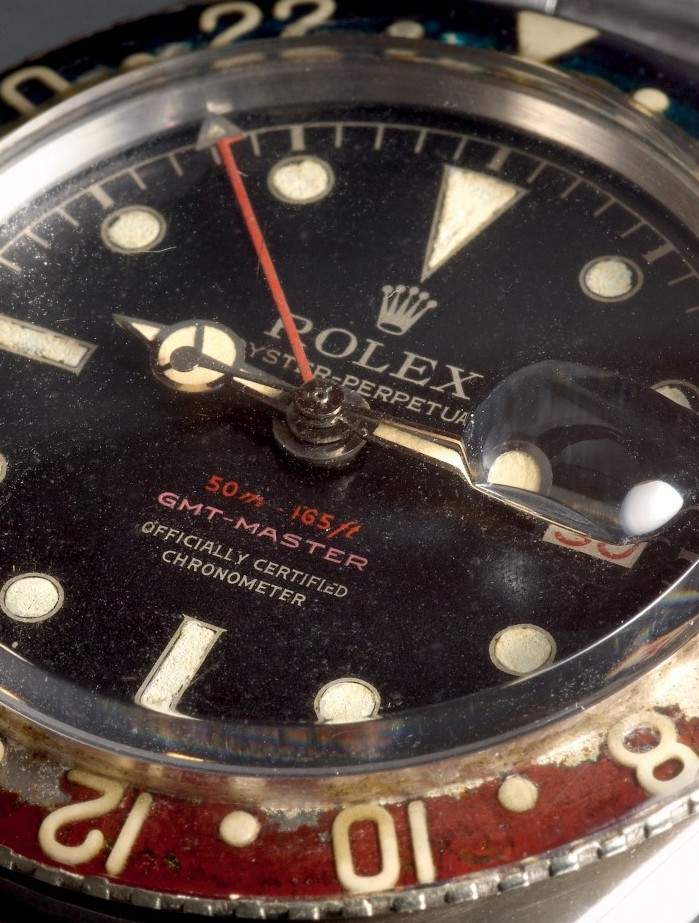
(Credit: J Goldberger)
Another short comment on the dial variations of the 6542 is needed before we move on.
There is alot of speculation on wether the 6542 came with underline dial or exclaimation point dials. According to my research and that of other experts (most notably the late Marcello Pisani) there were no underline or exclaimation point 6542 dials. Yes some versions of the 6542 are seen with underline dials (like this picture here) but they are clearly replacement dials and did not leave the factory like this (notice the white print writing and not gilt).
According to Pisani underline dials first came onto the market in 1962 when the 1675 had replaced the 6542 model.
Dial & Hands of ‘Normal’ black dial 6542 GMT Master
Lets get back to the black gilt dial ‘normal version’ of the 6542- which for me is the most beautiful version of the 6542 bakelite models.
As mentioned before most of the 6542 (except the earliest versions had normal ‘Mercedes’ type hour hands). The seconds hand for the first generation (and most probably all of the 6542 except perhaps for the very first batch of pink writing dials) also had to be white as can be seen on the picture below. Additionally to tell the second time zone, there was a long thin second hour hand that extended to the end of the dial and had a small triangle on the tip. In order to improve readability the 6542 came with cyclop lens crystal above the date which acts like a magnifying glass.
This was the first time Rolex would feature such a ‘cyclop’ lens.
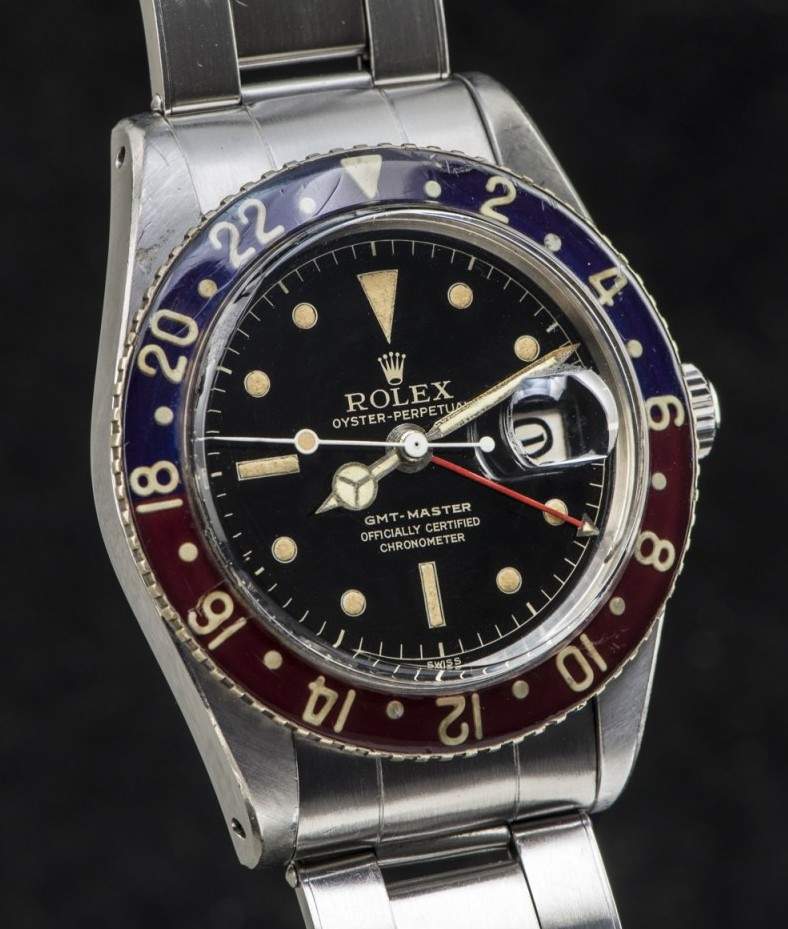
Case, case back and movement
The case of the 6542 is 38mm which was pretty standard size in the 1950s.
Submariners were also not bigger (even big crowns were only 37.5mm). The movement of the 6542 is a Cal 1030 automatic movement. What is interesting to note is that the movement (or better said ‘rotor’) has this called ‘butterfly’ shape (notice the two antenna below) which is similar to the other early Rolex sports-watch models such as the 6205 submariner.
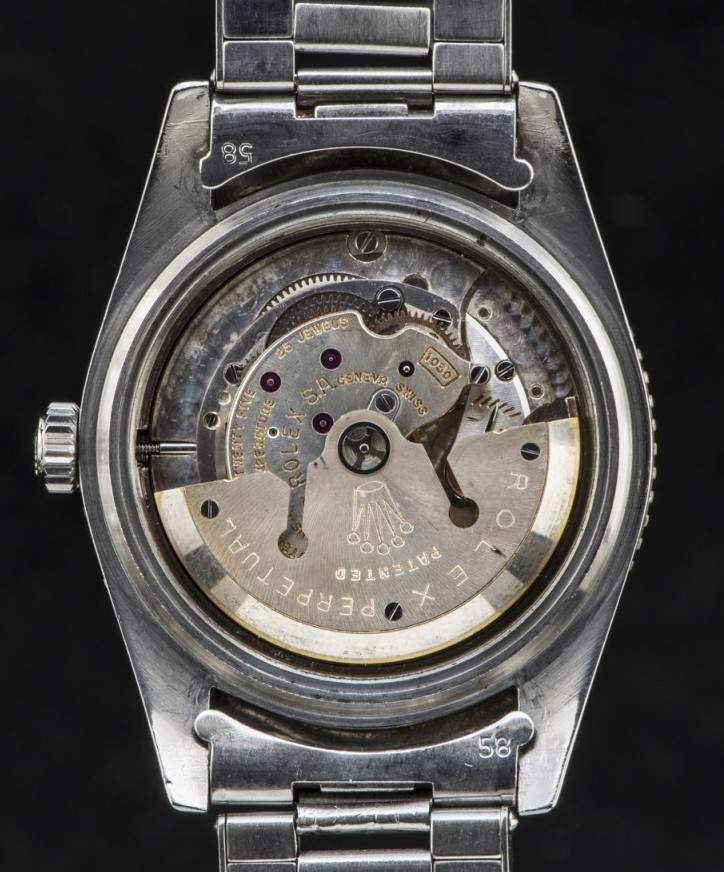
The case back of the 6542 is standard Rolex procedure.
The quarter and year indicates when the watch was made with the reference above the the date. What is interesting to note is that many early Rolex from the 1950s have the ‘octopus’ symbol also on the case-back. This is not seen with this 6542 despite its very early production date – this example must be one of the earliest examples of a 6542 Rolex ever made – from 1955.
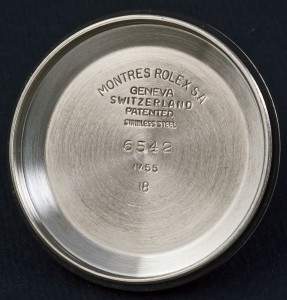
Papers & Box for the 6542
For some reason – it is very very unusual and rare to see the GMT booklet for the 6542.
I have seen plenty of GMT Booklets for the next model (1675) but the GMT 6542 instruction booklet is just very rare to come by. The papers for the 6542 come in two forms. 1) The first seems to be a pamphlet like the one you see below in Italian.

This paper is a fold out that is two pages long. I have found the same pamphlet in English. On the second page is the instruction manual on how to set the GMT Master 6542 with the second time zone.
This paper is very rare and I have rarely seen one for sale along with the 6542 watch.
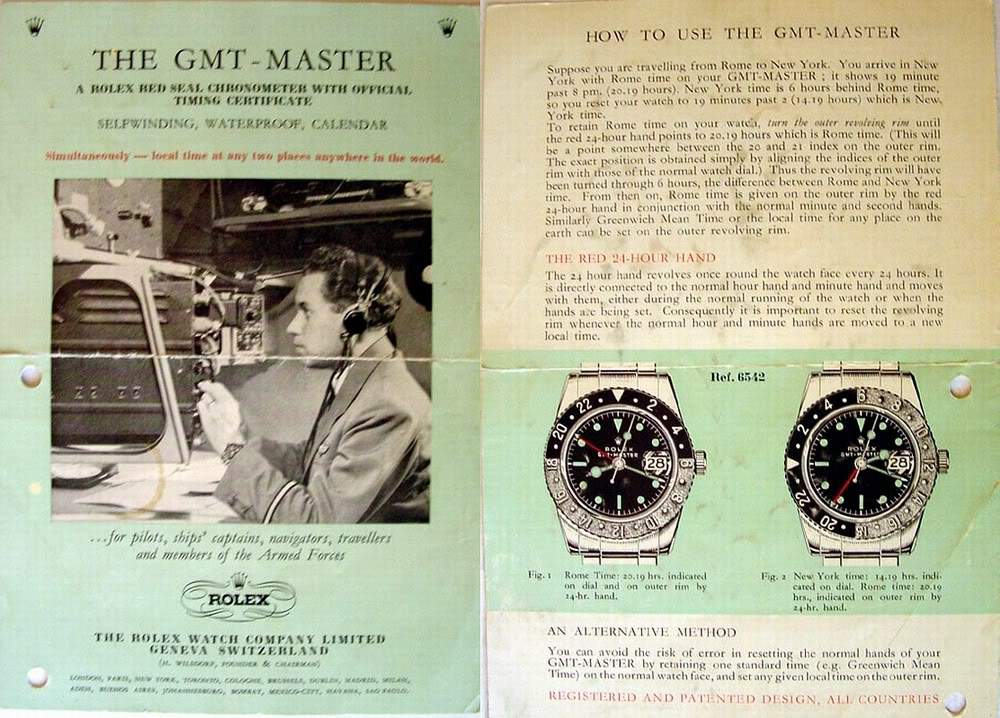
(Credit: Dr Strong PuristSPro)
The other paper for the 6542 is slightly different in form.
More similar in form to the papers we are familiar with – with the 1675 it looks more like a booklet and fold into four parts (see booklet below). Not only does it also contain the instruction manual but also the time difference in various time zones as well as the benefits a customer has in owning a 6542 GMT Master (two time zone indications, oyster case etc). This booklet I presume is more collectable and valuable given that this seems more like the instruction manual where the other pamphlet looks more like a pice of ‘marketing material’ that it gave potential customers interested in the 6542.
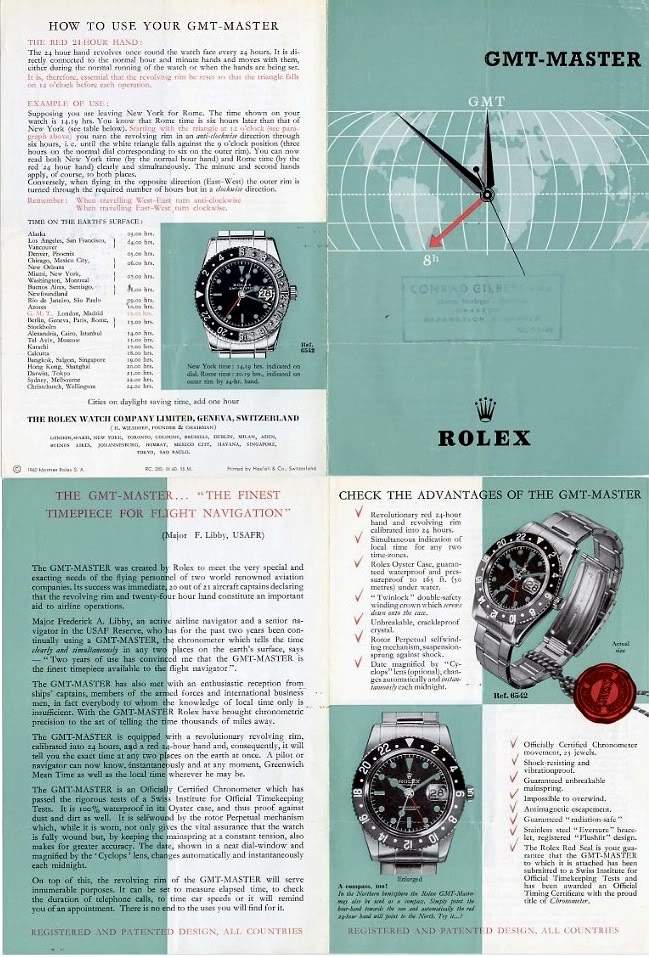
(Credit: Dr Strong PuristSPro)
Bakelite Bezel Insert
Perhaps the most important part of the 6542 GMT Master is the bakelite bezel – unique to this reference.
The bakelite bezel is important and deserves perhaps the most attention for this reference for many reasons.
First – the bakelite bezel is very rare. Secondly it was replaced by Rolex due to its fragility (in extreme heat or tropical climates the bakelite bezel tended to break). Third the bakelite is a beautiful item in itself – a piece of art – much more beautiful than the the plastic insert that would replace the bakelite insert in later 6542 references (yes the last batch of 6542 carried the non-bakelite bezel insert).
Lastly the bakelite bezel is interesting because Rolex carried out a recall due to the high use of radium present in the dial and on the bakelite bezel insert.
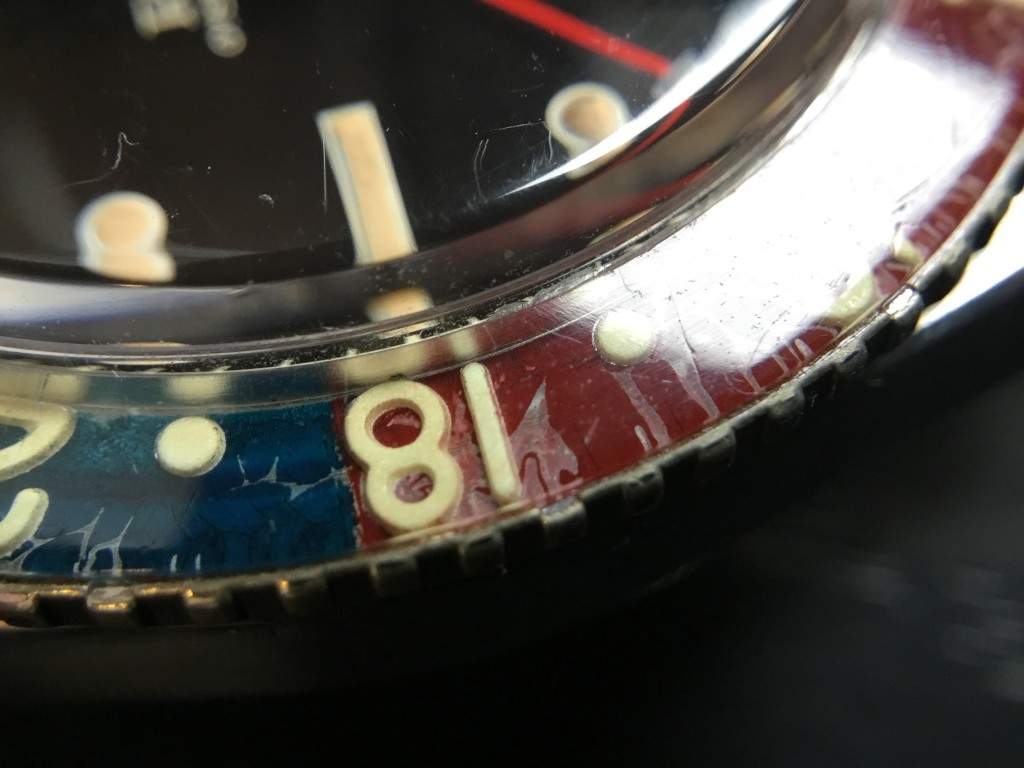
(picture credit: Mario Dissette)
Lets expand on each of the points.
Points one and two are directly related so we will address these points together. The problem with the bakelite was that it was fragile in nature and thus after a time, they would break, crack, chip and eventually be useless and disposed of. As a result there are very few bakelite bezels around that are fully in-tact. They are very rare. And this is also reflected in the price.
Last year just a bakelite bezel insert sold at Antiquorum for an astounding $32’5oo (see post here). Because of its fragility of the bakelite breaking Rolex replaced the bakelite bezel often at service when the owners would send in the watch. This only added to the rarity.
Lets address the third point: beauty.
If you look closely at the bakelite -especially of the watch in the main picture – the bezel is a piece of art. The richness in the colors is remarkable and the numbers on the bezel insert ‘seem to float on the bezel’ as one collector put it. While the red and blue bakelite is the version and color most often seen, Rolex also made a brown bakelite insert that is a dream too (see picture here)*. This bakelite was found on the gold 6542 version. Brown or blue/red – the bakelite bezel is a work of art.
The last point is important and explains the rarity factor behind bakelite bezels. Rolex recalled the bakelite bezel because of the high levels of radium found in the insert.
Below is an advertisement Rolex did to encourage owners to send their watches in for a free service replacement- this is another reason why the original bakelite bezels are very rare.
*Credit: Bubbleback watches / J. Singer
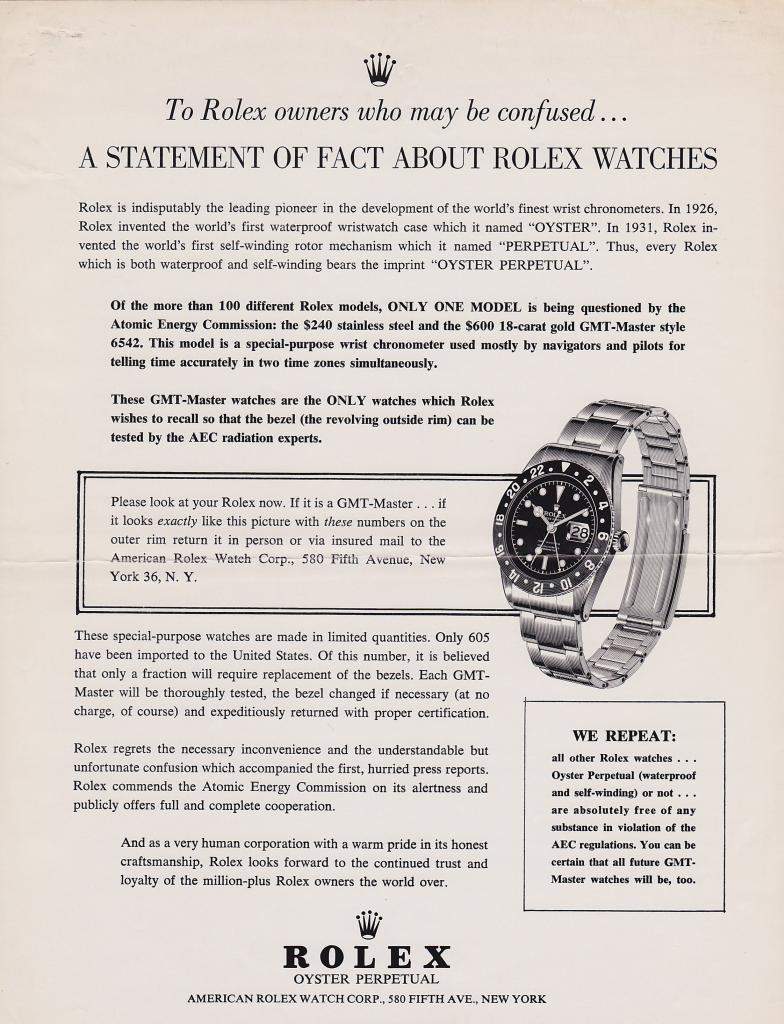
(Credit: Rolextimesource)
Presumably once Rolex replaced the bakelite insert and or if the owners were unsure if their GMT Master had bakelite or not Rolex would issue certificates (as the one below) stating that the owners had now bezels that were free of radium material in this case Strontium 90.
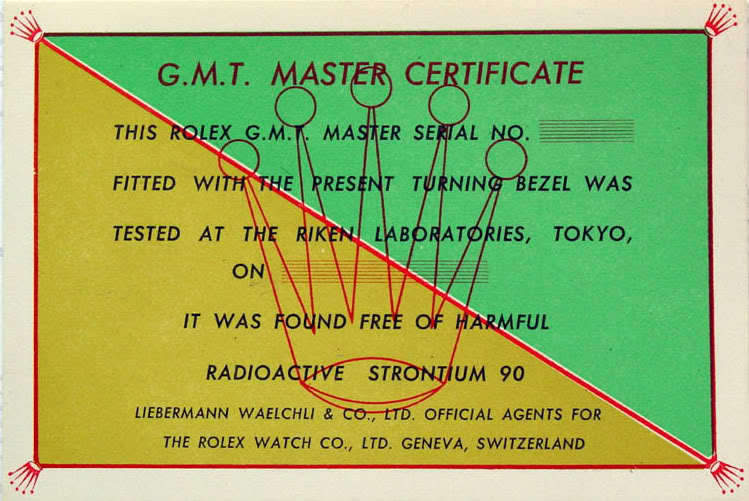
Bakelite – concerns for collectors
As beautiful as the bakelite bezels are for the 6542 – there are several things that collectors should pay attention to.
First, bakelite bezel inserts were very exposed to cracking. Therefore while there are a few 6542 with bakelite in the market and available at auction – most of them are partially cracked and or chipped. Collectors should pay strong attention to this. A cracked bakelite is sometimes not easy to spot. A cracked bakelite is worth approximately one fifth or 20% of a correct bakelite bezel that is undamaged.
The second main problem with the bakelite is that they are often ‘treated’. Much like an emerald is treated and oiled for a better color, some bakelite bezels are treated for cracks and imperfections. The result is that a bakelite will slightly discolor if treated and this can be seen by collectors if they pay close attention.
Discoloration can also take place due to the bezel being exposed to extreme heat. Therefore and this is an important point – not all discolored bezels are signs that have been ‘treated’ but rather some have been exposed to extreme heat. A good example of a bakelite that has been discolored either due to heat or possible ‘treatment’ is the one seen below. The watch was very nice example (especially the good condition of the dial) of a 6542 with the exception of the bakelite 6542 which was slightly discolored.
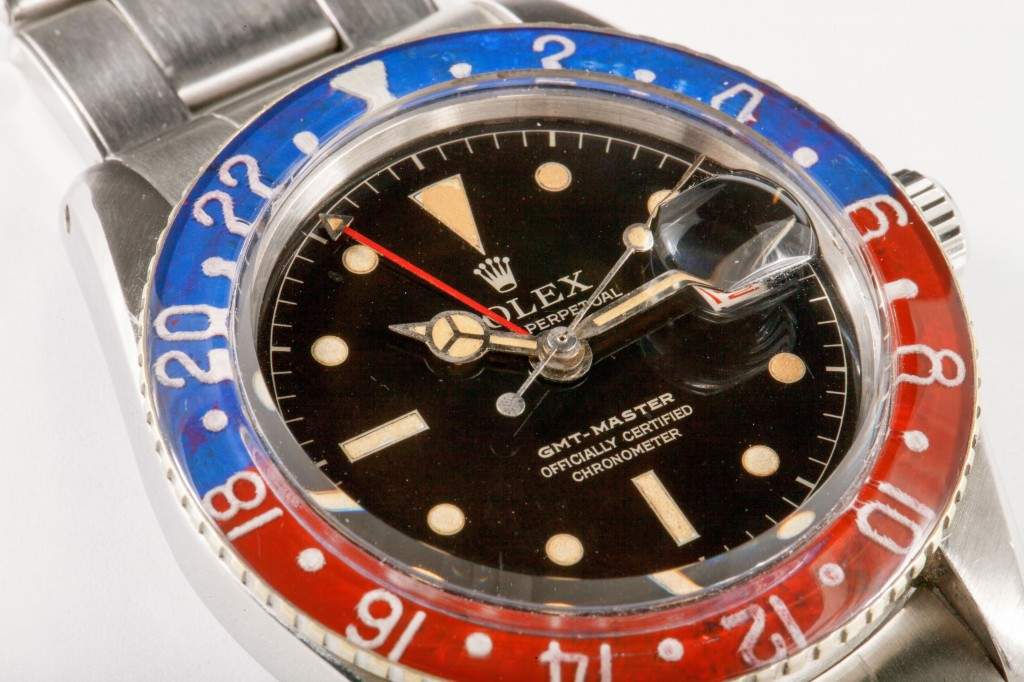
(Credit: Phillips watches)
The numbers on the bakelite bezel are not clear anymore and appear , at least in my view, like a watercolor painting that has been exposed to water.
Notice the ’20’ and the numbers ’22’ above where they almost seem blurred on the edge. Below is another picture of the close up of the bezel. Notice the lines that run through the numbers. The numbers almost seem ‘bushy and hairy’. Compare this to the watch that is the focus of this report (main picture) and you can clearly see a difference. This bezel is not as desirable due to the discoloring either because of heat over the years or because it was possibly ‘treated’. Despite the dial being very attractive – the watch did not end up selling at auction.
This is how serious collectors take issue with bakelite bezels. In short a bakelite bezel can make or break a 6542 at auction.
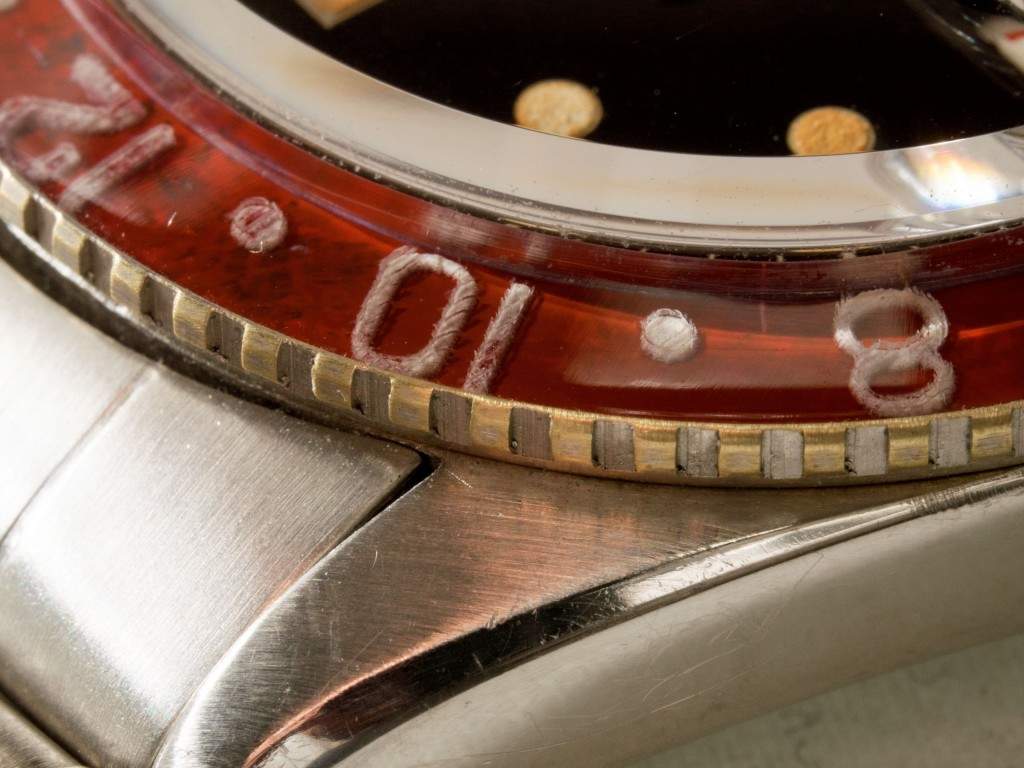
(Credit: Phillips watches)
For a contrast lets look at a near perfect bakelite bezel insert below.
Notice the numbers which are all intact and there are no cracks visible. Bakelite in this condition are very rare and almost impossible to find today. If you find a 6542 with a bakelite in this condition you are likely to pay a very large premium. The dial is this watch has turned to a barely noticeable brown.
A beautiful example of a 6542 indeed.
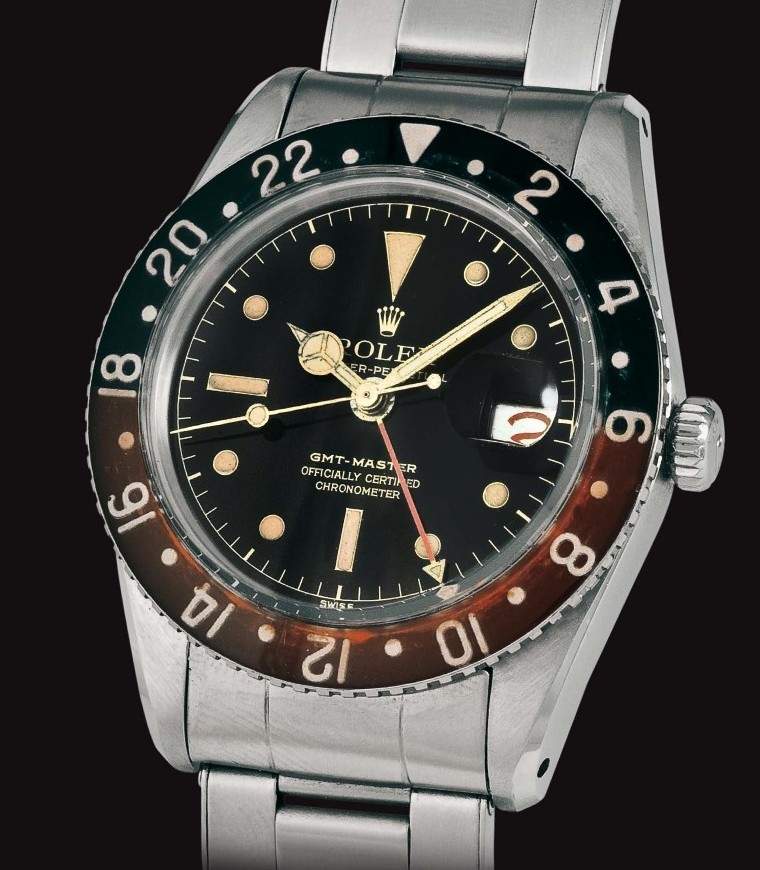
(Credit: J Goldberger)
Concluding remarks
The 6542 GMT Master is an milestone in Rolex history.
It is an icon and was the first dual time zone watch that Rolex introduced especially for PANAM pilots. Unlike with other references (where the more desirable versions are the later ones) the most beautiful and pure GMT Master 6542 are the first ones with a normal black gilt dial and bakelite bezel – as in the main picture of this report. Without knowing it Rolex would create one of the most desirable watches – as few GMT 6542 survive today with perfect bakelite bezels. When I think of tool watches from Rolex I think of two lines first and foremost. The GMT and the submariner. This will not change and there are enough collectors worldwide who think along the same lines.
This will insure that the 6542 GMT will remain an Icon not only in Rolex history but also for collectors who want something rare, beautiful and colorful.
(All pictures of the main watch presented in this report belong to K A.M – many thanks for allowing us to use the pictures).
Supplemental information and some wrist shots of the 6542.
No report would be complete without some wristshots of the 6542.
Below the watch of the main report on the owners wrist Mr K A.M, a Middle East watch collector with one of the strongest Rolex collections out there. Notice the strong bakelite condition (no cracks visible) and even more impressive the nice color of the bakelite. Additionally the dial seems to be in good condition.
A very nice 6542 in my opinion.
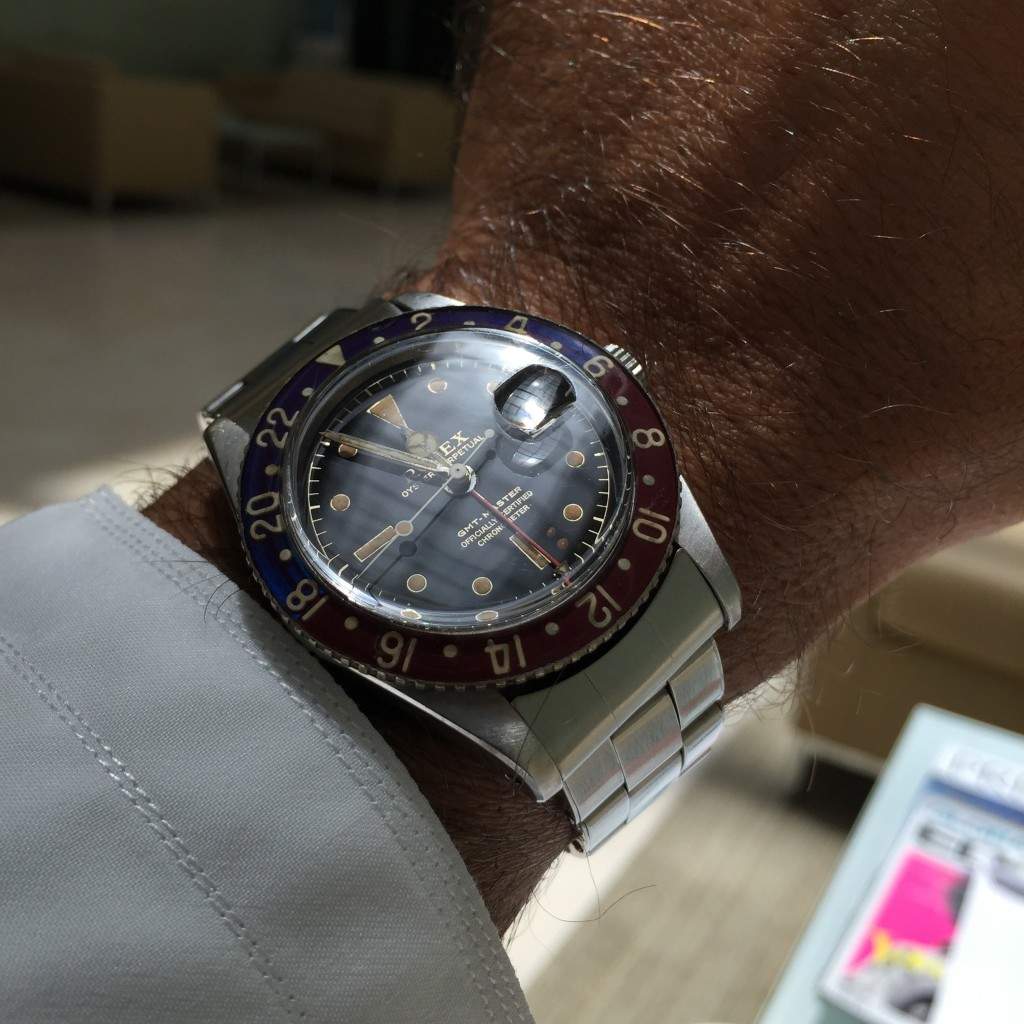
Another nice 6542 is this tropical dial owned by the author of this report. Notice the writing that has turned to white which is common on tropical or caramel dialed 6542.
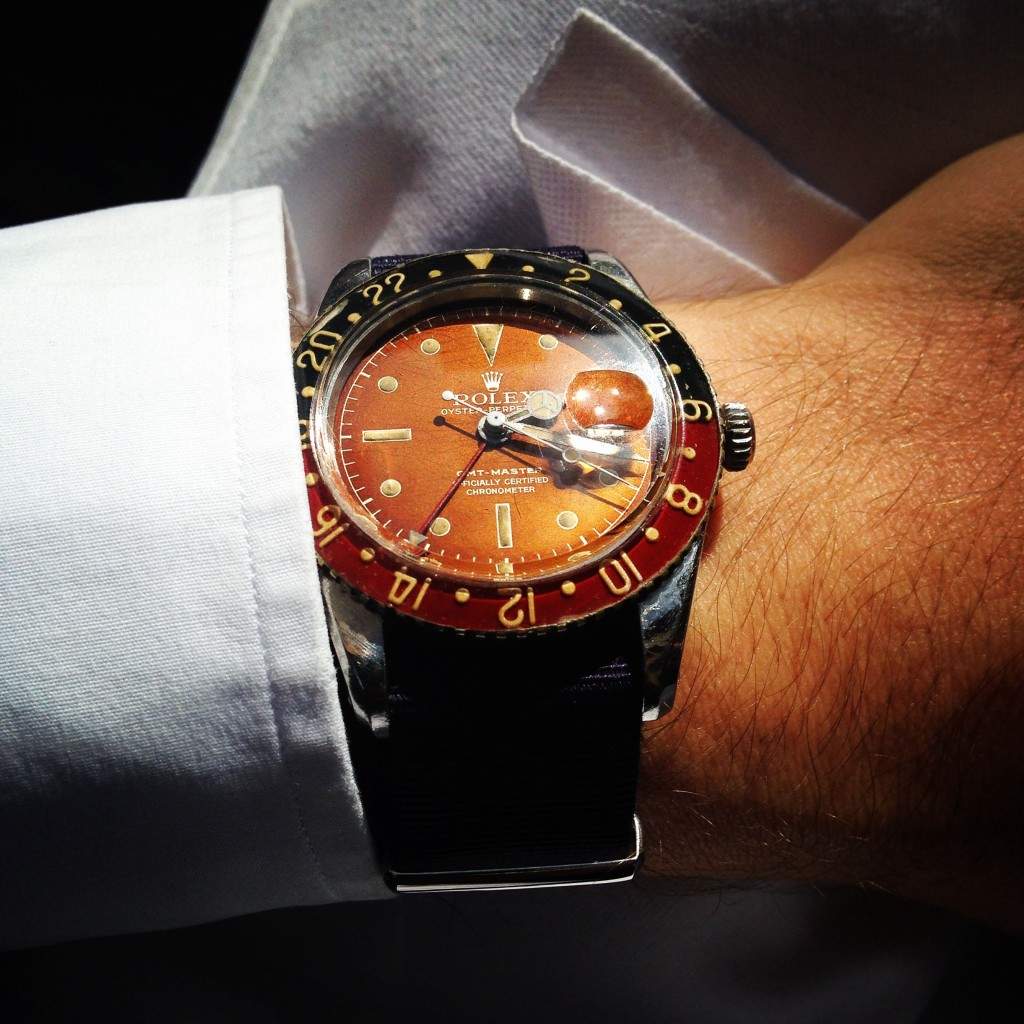
If you look closely at the Bakelite bezel below you notice the numbers are not blurry (as with the bakelite above in the report that was presumably ‘treated’ or discoloured from heat) but rather they are all in-tact. The bakelite bezel further stands out in a very pleasing and positive way as the color change of the bakelite bezel numbers nicely matching the lume on the dial of the watch.
The color of the bakelite is one of the nicest seen, it is a strong ‘oxblood’ like red and a beautiful dark blue.

Notice how the same watch – the tropical 6542 looks different under a dark light and flash. Same watch but different lighting.

Another dream 6542 in 18k gold with a superb all in tact bakelite bezel. This is one of the best examples of a 6542 that I have ever had the chance to try on. The brown dial and dark brown /back bakelite is one of the rarest 6542 available.
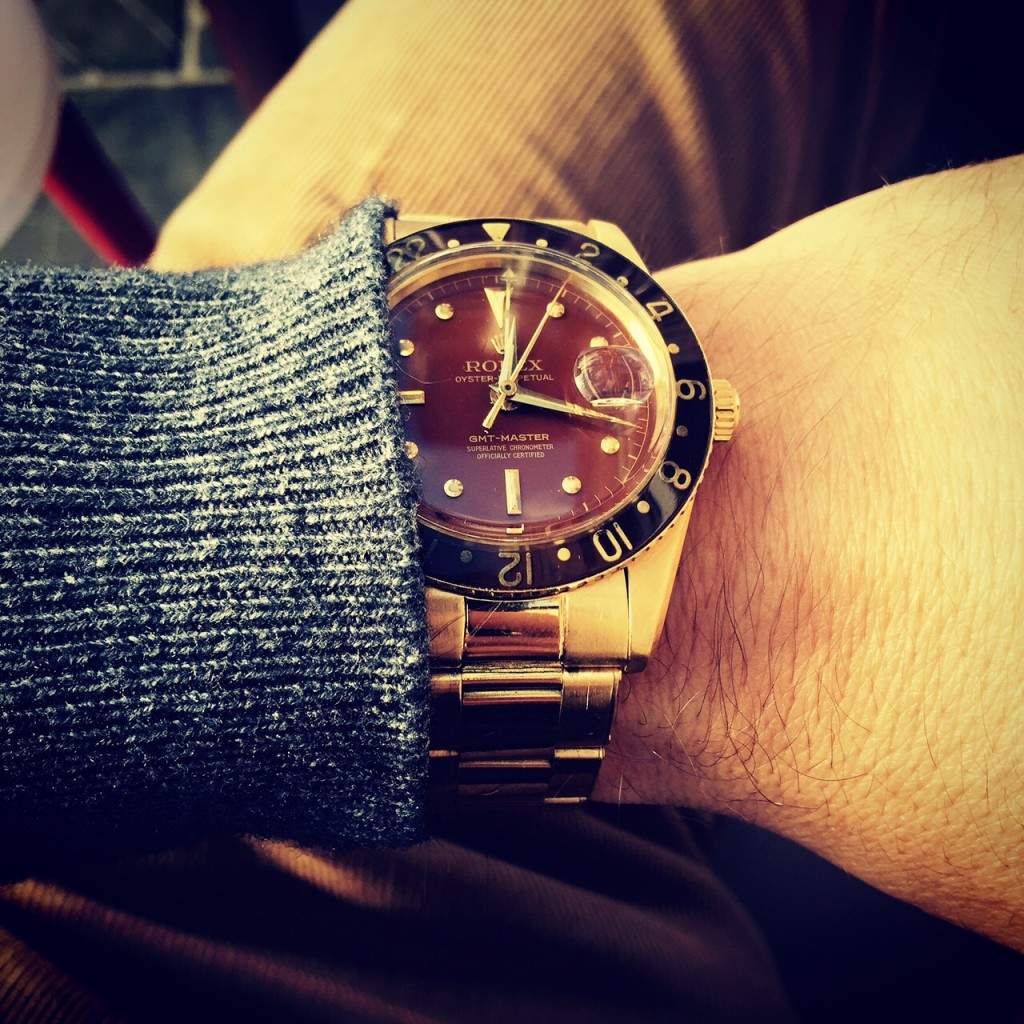
Another nice tropical 6542 below that recently sold at Christies in May 2016 for a new record for a tropical dial and steel watch for CHF 197’ooo. Belonging now to a NY collector.
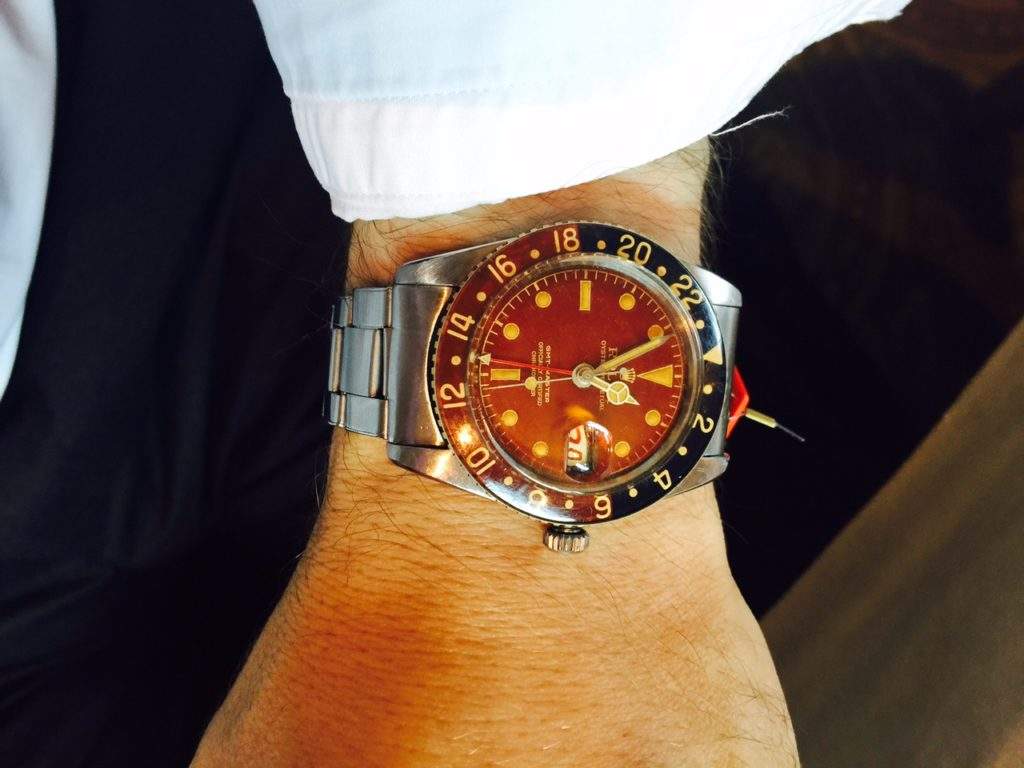
Not only airline pilots were known to wear the 6542. Movies stars and heads of State wore them too. Below Castro and his 6542 GMT Master.

(Credit: Smith PuristSPro)
Below the beautiful Honor Blackman also sporting a Rolex 6542 on her wrist (presumably on the set of Goldfinger). She was seen wearing one in Goldfinger, the third James Bond movie where she is charge of the women pilots squadron.

(Credit: Jakes Rolex world Blog).
